Class 8 Exam > Class 8 Notes > Year 8 Science IGCSE (Cambridge) > Chapter Notes: Forces and Energy
Forces and Energy Chapter Notes | Year 8 Science IGCSE (Cambridge) - Class 8 PDF Download
| Table of contents |

|
| Forces and Motion |

|
| Speed |

|
| Describing Movement |

|
| Turning Forces |

|
| Pressure between Solids |

|
| Pressure in Liquids and Gases |

|
| Particles on the Move |

|
Forces and Motion
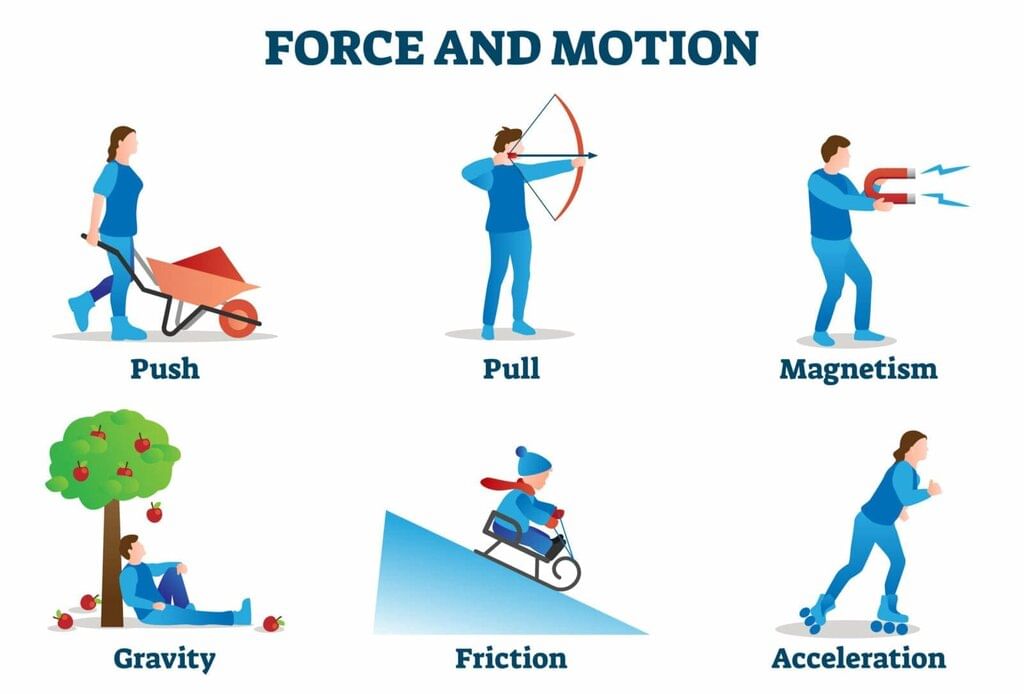
Balanced or Unbalanced?
- Balanced Forces: When forces acting on an object are balanced, they are equal in size and opposite in direction. This means the object will not change its motion. For example:
- A rock on the ground: The weight of the rock is balanced by the upward force from the ground.
- A rock pushed by the wind: The wind's force is balanced by friction with the ground.
- Force Diagrams: These diagrams visually represent the size and direction of forces using arrows. In a balanced force diagram, the arrows are equal in length and point in opposite directions, showing that the forces are balanced.
Starting to Move
- When forces acting on an object are unbalanced, one force is greater than the other, causing the object to move.
- For instance, if a vehicle pushes a rock with a force greater than the friction holding it back, the rock will move in the direction of the greater force.
Slowing Down
- A parachute slows down a falling object by creating air resistance that exceeds the object's weight. When the parachute opens, the forces acting on the object become unbalanced, leading to a decrease in speed. Initially, the parachute's opening creates a large amount of air resistance, which is greater than the weight of the falling object.
- This unbalanced force causes the object to slow down rapidly. As the object slows down, the air resistance acting on it also decreases because the speed of the object is reduced.
- Eventually, a point is reached where the air resistance becomes equal to the weight of the object. At this stage, the forces are balanced again, and the object falls at a constant speed, known as terminal velocity.
- Once the forces acting on the falling object are balanced again, with air resistance equal to the weight of the object, it continues to fall at a constant speed. This is because the net force acting on the object is zero, resulting in no further acceleration.
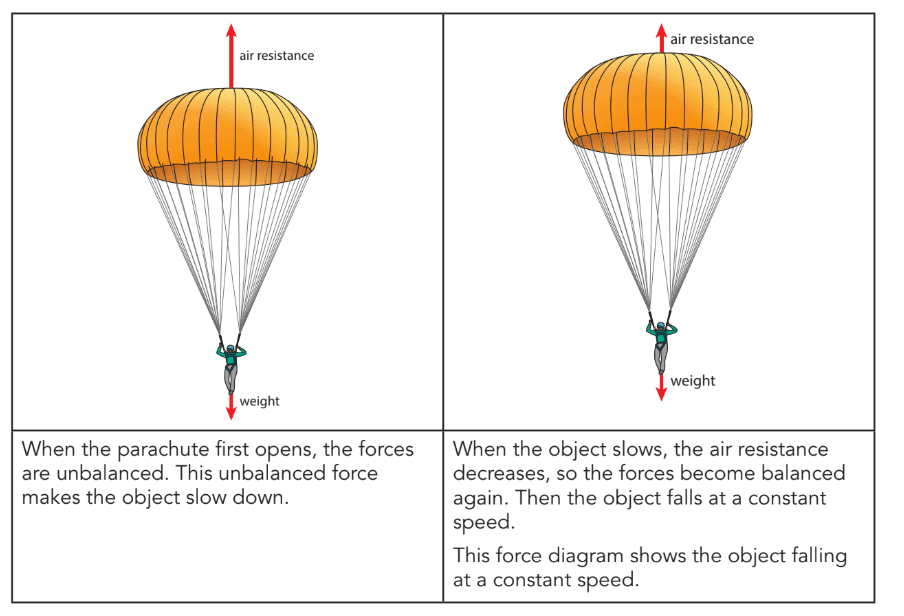
Changing Direction
- When a tennis ball hits a racket, it changes direction due to an unbalanced force.
- For the direction to change, the racket must exert a greater force on the ball than the ball exerts on the racket.
- This difference in force is what causes the ball to change its path and head in a new direction.
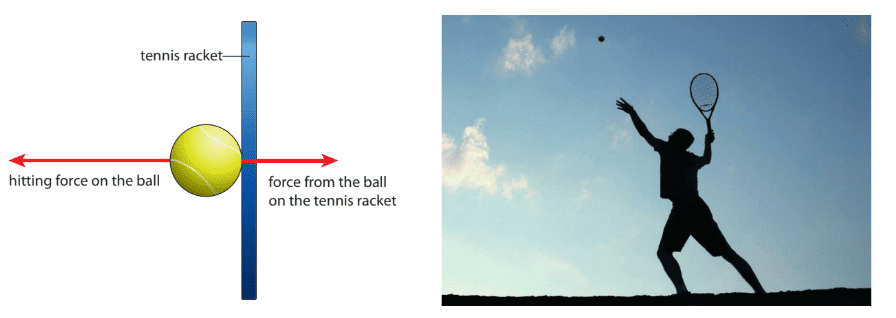
- The force of gravity acting on a planet is a constant unbalanced force that keeps the planet in orbit around the Sun. This unbalanced force is necessary to maintain the planet's circular motion.
- An unbalanced force is required to keep an object moving in a circle because, without it, the object would move in a straight line due to inertia.
- In the case of planets, the gravitational force exerted by the Sun is what provides the necessary unbalanced force to keep them in orbit. This force is constantly pulling the planets towards the Sun, preventing them from flying off into space.
Speed
Units of Speed
- Different units are used to measure speed depending on the context:
- Knots for ships.
- Mach for airplanes.
- Miles per hour (mph) and kilometres per hour (km/h) for road speed limits.
- Scientists use standard units globally, with the standard unit for speed being metres per second (m/s).
- "Per" means "in each," so "metres per second" indicates the number of metres travelled each second.
Calculating Speed
- Speed is calculated in metres per second (m/s).
- For example, if a bus travels 100 metres in 20 seconds, we can calculate speed:
- Speed = Total Distance (100m) ÷ Total Time (20s) = 5 m/s.
- This can be summarised as: Speed = Distance ÷ Time.
- Average speed is used when speed varies during a journey. The speed formula can also be rearranged to find:
- Distance = Speed × Time.
- Time = Distance ÷ Speed.

Describing Movement
- Distance–time graphs are useful for showing the relationship between distance and time during a journey. They help to describe movement by plotting distance on the vertical axis and time on the horizontal axis.
- These graphs make it easier to identify trends and patterns in the data, read distance or time values, calculate other values such as speed, and provide a clear overview of the entire journey.
Section 1: From A to B
- Starting Position: At position A, the car's distance travelled is zero.
- Constant Speed: The car moves towards point B at a steady speed, covering the same distance every second. This is represented by a straight, upward-sloping line on the distance–time graph, indicating consistent progress.
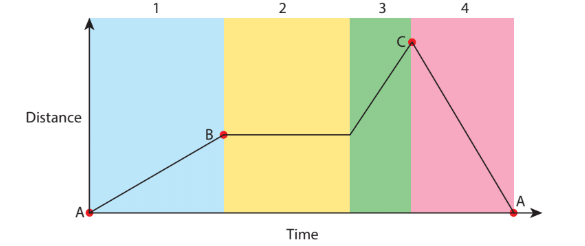
Section 2: At Point B
- Stopping at Point B: When the car reaches point B, it comes to a stop and is stationary, with a speed of zero.
- Horizontal Line on Graph: The distance from the starting position remains constant while time continues to pass, which is shown by a straight, horizontal line on the graph.
Section 3: From B to C
- After Point B: Following a brief stop at point B, the car resumes moving towards point C at a constant speed.
- Steeper Line on Graph: The car covers more distance each second during this segment, which is represented by a steeper upward line on the distance–time graph, indicating an increase in speed.
Section 4: From C to A
- Returning to A: Once the car reaches point C, it begins to return to the starting position A at a constant speed.
- Downward-Sloping Line: The distance decreases over time as the car heads back to A, which is shown by a straight, downward-sloping line on the graph.
Sketch vs. Detailed Distance–Time Graphs
- The distance–time graph is a sketch without numerical values on the axes.
- Some graphs include values for calculations, allowing you to read distance and time directly.
Turning Forces
Turning Effects of Forces
- Applying a force to an object can make it turn around a fixed point, known as the turning effect of forces. For example, pushing down on a door handle causes it to rotate around its pivot point.
- Similarly, pushing down on a bicycle pedal makes it turn around its pivot point. Pulling on a door handle makes the door rotate around its hinges, the pivot point. The human body uses levers and pivots to move, like bending an arm where the elbow acts as the pivot.

Calculating Moments
- The moment of a force is its turning effect, depending on:
- The size of the force: A larger force creates a greater moment.
- The distance from the pivot: A greater distance increases the moment.
- Moment Calculation: Moment = Force × Distance. Here, distance is from the pivot to where the force is applied.
- Units: The unit of force is the newton (N) and distance is in metres (m), making the unit of moment newton metre (Nm).
Balancing Moments
- A seesaw is a lever. When people sit on either side, they create moments that make it turn.
- A seesaw is balanced when the moments on both sides of the pivot are equal and opposite.
Pressure between Solids
The Pushing Effect of a Force
- Pressure is the pushing effect of a force applied over an area. This is important for understanding how tools and methods can change pressure to achieve tasks. For example, a knife cutting through modelling clay relies on pressure:
- Increasing the force on the knife raises the pressure, making it easier to cut.
- A sharper knife has a smaller contact area, which increases pressure and makes cutting easier.
- Pressure = Force ÷ Area.
Units of Measurement
- Pressure is measured in newtons per metre squared (N/m²).
- When area is in square centimetres (cm²), pressure is in N/cm²; in square millimetres (mm²), it is N/mm².
Increasing Pressure with Smaller Areas
Some objects are designed to reduce pressure by increasing the area of force application:
- Camels have large feet that distribute their weight over a large area, reducing pressure on sand.
- A woman on a bed of nails experiences low pressure from each nail due to her weight being spread across many nails.
Increasing Pressure with Sharp Points
Some objects use sharp points to increase pressure by reducing contact area:
- Pins have sharp points that concentrate force, increasing pressure for easy penetration.
- Scissors have sharp blades with a small cutting edge area, increasing pressure for cutting materials.
Pressure in Liquids and Gases
Pressure in Liquids
- Pressure in a liquid increases with depth.
- As you dive deeper, more liquid above you pushes down due to gravity, increasing pressure on the particles below.
- Particles move in all directions, resulting in equal pressure from all sides.
Pressure and depth in liquid
- The wall of a dam is wider at the bottom than at the top due to increasing water pressure with depth.
- Water pushes against the dam wall with greater force as the depth increases.
- The wall's design makes it stronger where the pressure is highest.
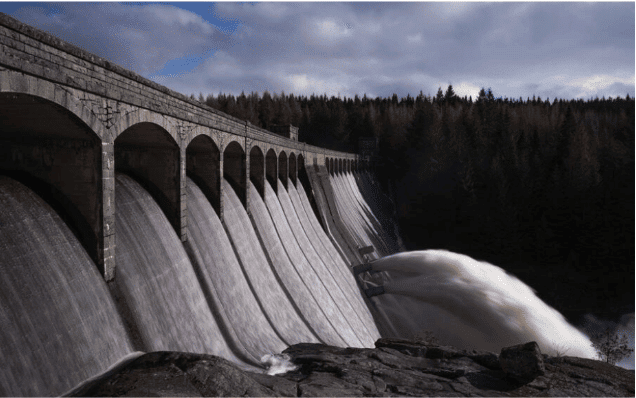
Pressure in Gases
- Initially, a balloon has low air volume, with equal pressure inside and outside. Blowing air into the balloon increases the number of gas particles inside. Gas particles collide with the walls, creating more force and higher pressure. As more air is added, the pressure increases, causing the balloon to expand.
- For Example: A tire with low air pressure cannot support a vehicle's weight. Adding air increases pressure, leading to more collisions and pushing the tire outward.
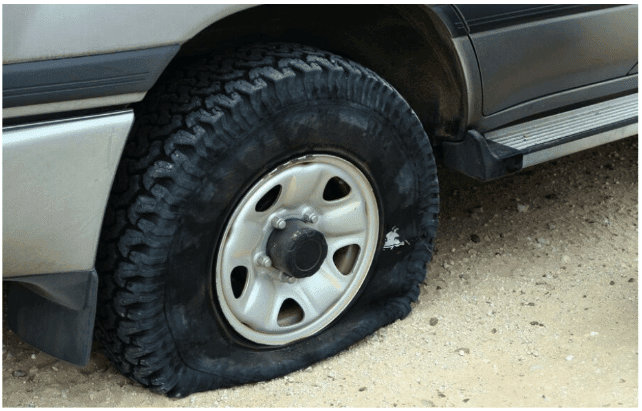
Pressure and Depth in Gases
- Like liquids, pressure in gases increases with depth. At sea level, the atmosphere is at its deepest, resulting in the highest pressure.
- As you ascend, the number of air particles and weight of air above decrease. Atmospheric pressure at sea level is about 101,325 pascals, equivalent to two large elephants pushing on every square metre!
Effects of Atmospheric Pressure
- When air is pumped out of a metal container, the pressure inside drops significantly compared to the outside pressure.
- This difference crushes the container due to the atmospheric pressure from outside.
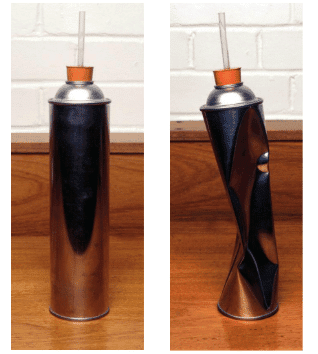
Pressure and Temperature in Gases
- As the temperature of a gas increases, particles move faster and collide with greater force. This leads to higher pressure in the gas.
- For Example: Pressure cookers use high pressure to cook food quickly. Inside, water and food are sealed. As water boils, steam builds up, increasing pressure. A weight on top regulates pressure, allowing excess steam to escape once the desired pressure is reached.
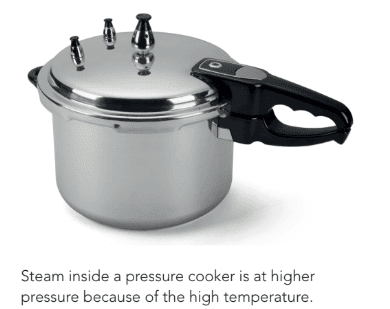
Particles on the Move
Mixing Gases
- In a gas, particles move randomly in speed and direction. When two gases are mixed in one container, they spread out to fill the space.
- The movement of particles from areas of high to low concentration is called diffusion. Concentration refers to the number of particles in a particular volume.
- Initially, gas particles are concentrated on one side. When a tap opens, they spread into each other's space. Gases continue to diffuse until concentrations are equal, though individual particles keep moving.
- Heating food releases gas particles that spread through the air by diffusion. As you approach, the smell becomes stronger because of the higher concentration of particles.
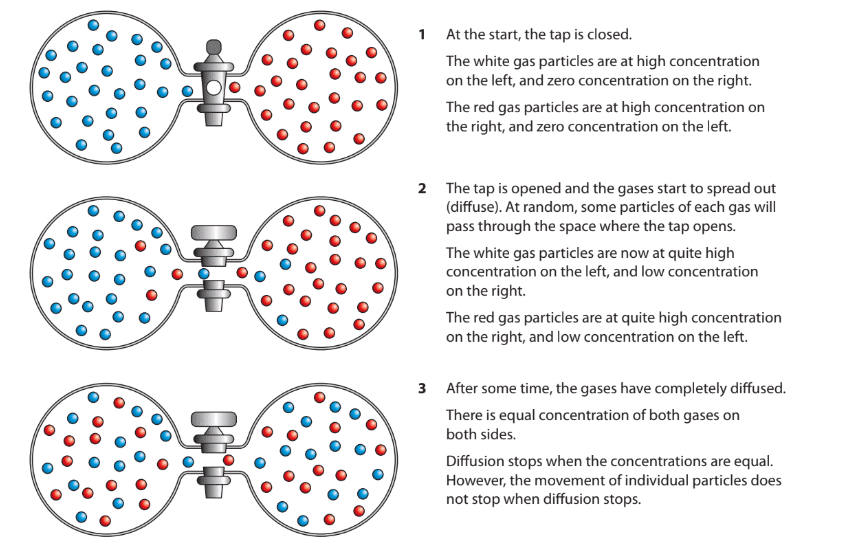
Mixing Liquids
Diffusion also occurs in liquids; for example, blue ink spreads when added to water until evenly distributed.
Speed of Diffusion
Several factors influence the rate of diffusion:
- Concentration Difference: Greater differences speed up diffusion.
- Temperature: Higher temperatures increase particle speed, allowing quicker diffusion.
The document Forces and Energy Chapter Notes | Year 8 Science IGCSE (Cambridge) - Class 8 is a part of the Class 8 Course Year 8 Science IGCSE (Cambridge).
All you need of Class 8 at this link: Class 8
|
3 videos|55 docs|9 tests
|
FAQs on Forces and Energy Chapter Notes - Year 8 Science IGCSE (Cambridge) - Class 8
| 1. What is the formula for calculating speed? |  |
Ans. The formula for calculating speed is Speed = Distance ÷ Time. This means that to find the speed of an object, you divide the total distance it has traveled by the time it took to travel that distance.
| 2. How do distance-time graphs represent motion? |  |
Ans. Distance-time graphs show the relationship between the distance an object travels and the time it takes. The slope of the line on the graph indicates the speed of the object. A steeper slope means a higher speed, while a flat line indicates that the object is at rest.
| 3. What are the turning effects of forces and how are they calculated? |  |
Ans. The turning effects of forces are known as moments. A moment is calculated by multiplying the force applied by the distance from the pivot point to where the force is applied. The formula is Moment = Force × Distance from the pivot.
| 4. How can we balance forces acting on an object? |  |
Ans. To balance forces acting on an object, the total force acting in one direction must equal the total force acting in the opposite direction. When forces are balanced, the object remains at rest or continues to move at a constant speed.
| 5. What is the significance of changing direction in motion? |  |
Ans. Changing direction in motion is significant because it affects the velocity of an object, even if its speed remains constant. This change can result from the application of forces, and it is crucial in understanding concepts like acceleration and momentum.
Related Searches















